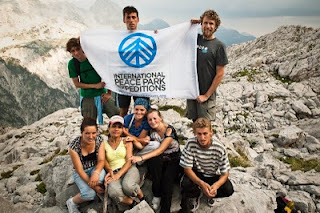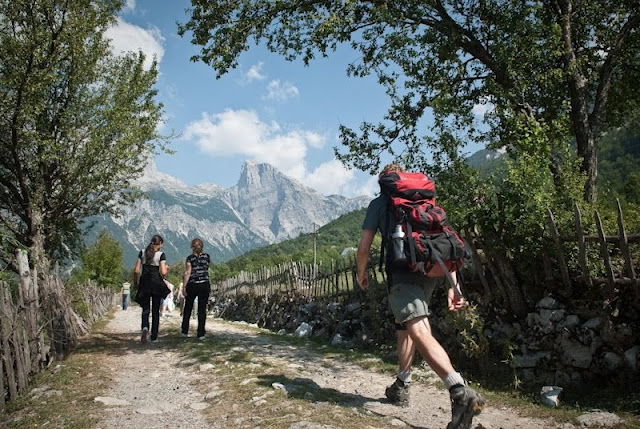Showing posts from category eco-tourism.
-
Imagine There Are No Countries: Conservation Beyond Borders in the Balkans
›International peace parks have captured the imagination of visionaries like Nelson Mandela, who called them a “concept that can be embraced by all.” Such parks—also known as transboundary protected areas—span national boundaries, testifying to the peaceful collaborative relationship between neighboring countries and to the co-existence of humans and nature.
Peace parks seek to simultaneously promote regional peace and stability, conserve biodiversity, and stimulate job creation. How can they accomplish such ambitious goals?- Biodiversity: The political borders and physical barriers within the park are removed, allowing animals and humans to migrate freely. In addition, surveys of the area’s biodiversity don’t stop at sovereign borders, but are instead conducted on an ecosystem basis.
- Job creation: Developing eco-tourism—one of the fastest-growing industries in the world—provides people living near peace parks an incentivized alternative to exhausting the very resource base on which their survival depends.
- Peace and stability: To jointly manage natural resources successfully requires countries to collaborate through cross-boundary committees on conservation, safety and security, finance, human resources, legislation, and tourism.
 My organization, International Peace Park Expeditions, uses experiential peacebuilding, academic programs, and professional trainings in international peace parks to integrate theory with practice. We seek to develop leadership and collaboration among three distinct, but complementary, groups: students and professors, transboundary protected area professionals, and youth from the peace park countries.
My organization, International Peace Park Expeditions, uses experiential peacebuilding, academic programs, and professional trainings in international peace parks to integrate theory with practice. We seek to develop leadership and collaboration among three distinct, but complementary, groups: students and professors, transboundary protected area professionals, and youth from the peace park countries.
Our Summer 2010 programs focus on the proposed peace park in the Western Balkans’ Prokletije/Bjeshket e Namuna mountains, between Albania and the newly independent countries of Montenegro (2006) and Kosovo (2008), which were formerly part of Yugoslavia. The Balkans Peace Park Project, a UK charity and their local network of partner organizations and individuals, first conceptualized the Balkans Peace Park, an area of approximately 4000 square km, in 2001.
This summer, participants in our professional training symposium will collaboratively develop a more precise and dynamic map. Students and young leaders in our other two programs will learn about peace parks while trekking together across the borders into all three countries.
Experiential Peacebuilding (July 19-25, 2010)
Experiential Peacebuilding programs combine outdoor experiential education and practical skills training in peacebuilding to foster the development of a community of young leaders capable of catalyzing positive peaceful changes in their communities. This summer’s program is being developed in conjunction with our local partner organizations (ERA and Marimangut in Kosovo; Outdoor Albania and High Albania in Albania; and PSD Prokletija in Montenegro). The primary goals of these programs are to unite youth from conflict-affected communities to develop relationships across borders; transform negative attitudes and stereotypes; and create a core group of young leaders with the skills, tools, and motivation to generate and direct changes in their communities.
Academic Expedition (June 7-26 and August 2-21, 2010)This three-week, three-credit course, “Conservation Beyond Borders,” will combine traditional academic teaching with proven experiential learning methodologies to create a unique, dynamic expedition that will provide students with a strong understanding of the theory and practice of international peace parks. Course readings and lectures will provide the academic base, and guest lectures from subject-matter experts working in the field will create the bridge; both will address sustainable forestry management, biodiversity surveys, eco-tourism plans, development and infrastructure planning, environmental conservation, water resource management, peacebuilding initiatives, and cross-border projects. First-hand experience trekking through the proposed Balkans Peace Park, crossing the borders of Albania, Kosovo, and Montenegro, and living among the local people will bring theory to life.
Professional Training Symposium (July 8-9, 2010)
This year’s Professional Field Training Symposium, “Critical Transboundary Environmental Linkages,” will bring together experts, policymakers, and stakeholders from the Prokletije/Bjeshket e Namuna region to discuss cross-border ecotourism, biodiversity mapping, and sustainable forestry management. The symposium seeks to build trust through cross-border collaboration, and to improve environmental management in the peace park region. Participants will create a Google Earth map to house shared environmental data and visit two project sites in the proposed peace park. Todd Walters is the founder and executive director of International Peace Park Expeditions. He holds a master’s degree in International Peace and Conflict Resolution from American University’s School of International Service, and is a National Outdoor Leadership School (NOLS) certified wilderness guide. While at AU, he worked as an intern for the Environmental Change and Security Program.
Todd Walters is the founder and executive director of International Peace Park Expeditions. He holds a master’s degree in International Peace and Conflict Resolution from American University’s School of International Service, and is a National Outdoor Leadership School (NOLS) certified wilderness guide. While at AU, he worked as an intern for the Environmental Change and Security Program.
Photos courtesy IPPE/Cory Wilson. -
An Island of Peace in a Sea of Conflict: The Jordan River Peace Park
›Saleem Ali filmed this video on his visit to the “peace island” between Jordan and Israel, which Friends of the Earth Middle East (FOEME) is working to convert into an international peace park.
FOEME co-Director Gidon Bromberg will be at the Wilson Center today to discuss the peace park and other FOEME water cooperation initiatives in more detail as a panelist participating in “Pathways to Peace: Stories of Environment, Health, and Conflict,” an event discussing field-based lessons for addressing environment, health, development, and conflict.
Video: Filmed by Saleem H. Ali (University of Vermont, editor of the MIT Press book Peace Parks: Conservation and Conflict Resolution) with commentary by Elizabeth Ya’ari (FOEME), January 2010. -
Eco-Tourism: Kenya’s Development Engine Under Threat
› Africa’s elephants and black rhinos—already at risk—are increasingly threatened as the price of black market ivory rises, global markets contract, and unemployment rates rise. To fight poaching of these tusked animals, Ian Craig, founder of the Lewa Conservancy in Kenya and the brains behind the Northern Rangelands Trust, takes a unique approach to conservation that involves both local community members and high-level government officials, as well as private and public sector investors.
Africa’s elephants and black rhinos—already at risk—are increasingly threatened as the price of black market ivory rises, global markets contract, and unemployment rates rise. To fight poaching of these tusked animals, Ian Craig, founder of the Lewa Conservancy in Kenya and the brains behind the Northern Rangelands Trust, takes a unique approach to conservation that involves both local community members and high-level government officials, as well as private and public sector investors.
In the 1970s the black rhino population was at about 20,000. Less than three decades later, it had fallen to 200. Today, the population is about 600, of which 79 live in the Lewa Conservancy. The vast regions of Kenya covered by the Northern Rangelands Trust and the Lewa Conservancy are difficult to govern, so the conservancies partner with local communities to ensure the security necessary to protect the animals from poachers. By investing in community institutions, the conservancies create long-term sustainability and self-sufficiency.
But why should local communities—often beset by poverty, disease, and hunger—care about saving elephants or rhinoceroses rather than killing them for their tusks or meat? Revenue from tourism can total hundreds of thousands of dollars, especially because of the high cost and exclusive nature of tourism facilities in the area. This money is then injected back into community programs to improve adult literacy, school nutrition, health care, micro-credit, water and irrigation systems, community livestock and agriculture, and forestry and aquaculture.
In some politically volatile areas, the conservancy serves not only as a platform for ecological security, but also as a mediator of disputes. Where livestock theft is rampant, multi-ethnic anti-poaching teams have been able to act as intermediaries. Community elders and other traditional leaders serving on the conservancies’ boards have bi-annual meetings to further intra- and inter-regional cooperation. Along with regular managerial and council meetings, the board meetings set standards for good practices, open dialogue for policymaking and cooperation, and act as a unique platform for communication between different ethnic and regional groups.
Community members understand they have a stake in protecting not only the animals, but in ensuring security and building trust within the country. With its unique combination of local-level engagement, the cooperation and support of the Kenyan Wildlife Service and the national government, and with the resources available to the conservancies as a group, the Lewa Wildlife Conservancy hopes to create a model of conservation that can be used across Africa and in other at-risk regions.
The future is shaky: ivory prices continue to rise, the migration of animals has facilitated poaching, and small arms are abundantly available. However, the new community-focused approach has helped to create positive attitudes that aren’t just about saving animals, but about developing the nation.
Justine Lindemann is program assistant with the Africa Program at the Woodrow Wilson International Center for Scholars.
Photo: Elephants in Lewa Conservancy area, courtesty Flickr user Mara 1





 Africa’s elephants and black rhinos—already at risk—are increasingly threatened as the
Africa’s elephants and black rhinos—already at risk—are increasingly threatened as the 

